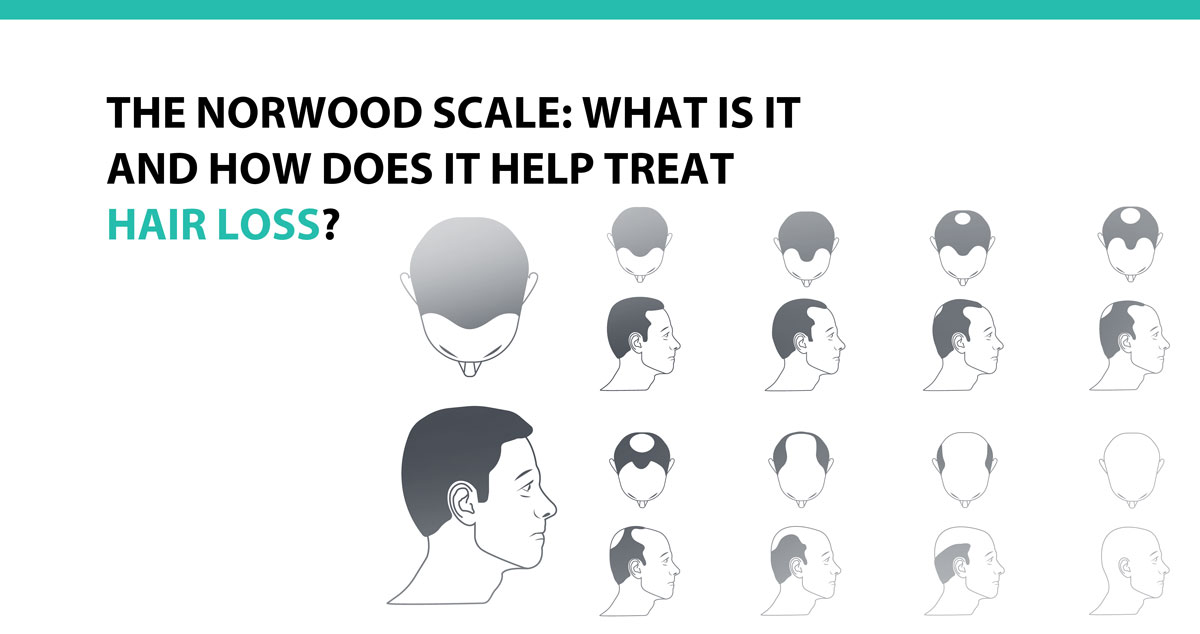
Male pattern baldness is an issue that plagues millions of men, but thankfully there are a variety of restoration options available that can stop hair loss in its tracks.
If you’re experiencing male pattern baldness and are looking to take the first step in the hair restoration process, the Norwood scale is an excellent tool. It not only helps you understand what to expect in your journey but can narrow down the best restoration options for you.
Here, we’ll review what the Norwood scale is and how it can help you acquire the full head of hair you’re looking for.
What’s the Norwood scale?
The Norwood scale, also known as the Hamilton-Norwood scale, is a way to measure the extent of hair loss due to male pattern baldness. As the leading classification system and most commonly used, it’s an easy way for those who are experiencing male pattern baldness to see where they stand on the hair loss spectrum.
The scale – first introduced by James Hamilton back in the 50s and later revised by O’Tar Norwood in the 70s – classifies baldness into seven stages, which we’ll review now.
The 7 stages of the Norwood scale
Stage 1: At this stage, there is no significant hair loss, including at the hairline.
Stage 2: Slight hair loss is noticeable, including recession of the hairline and possibly around the temples.
Stage 3: Significant balding is noticeable. The hairline is very recessed at the temples, and those spots are either completely bare or are sparsely covered. At this stage, the hairline resembles an M, U, or V shape.
Stage 3 subset: It’s possible to have stage 3 vertex, in which the hairline at the temples stays intact and significant hair loss occurs instead at the top of the head – the vertex.
Stage 4: The hair loss is more severe than stage 3, with little or no hair at the vertex. At this stage, there is still a strip of hair that connects the hair that remains on both sides of the head.
Stage 5: Similar to stage 4, except the hair loss is more severe, and the strip of connecting hair is narrower.
Stage 6: This is the stage in which the hair recession at the temples joins with the balding vertex. The connecting strip of hair is either nonexistent or very sparse.
Stage 7: The most severe stage of hair loss, the top of the head is nearly entirely bald, and just a band of hair around the sides of the head remains.
How does the Norwood scale help treat hair loss?
The Norwood scale is very beneficial for those interested in their hair transplant or restoration options. How? It can help confirm that the hair loss is, in fact, from male pattern baldness. Knowing the underlying cause of hair loss is vital to effectively treating it.
It also helps professionals, like the team here at our Las Vegas hair transplant surgery center, identify the severity of the loss. Knowing the starting point is another vital component of treating hair loss. For example, the same treatment for someone in stage 3 may not be applicable to someone with more severe hair loss, like stage 6 or 7. Plus, it can help measure the success of the hair restoration route taken.
Knowing where you stand on the Norwood scale also helps you understand what to expect should you decide not to pursue restoration options.
Find where you are on the scale today!
With today’s advancements in hair transplant and restoration options, you don’t have to simply accept where you are on the scale and deal with male pattern baldness for the rest of your life. There are many hair loss solutions available no matter where you fall on the scale. So, what’s the first step? Knowing exactly where you stand and what your options are.
With help from Doctor Joseph Williams and the Advanced Medical Hair Institute team, you can gain a better understanding of your male pattern baldness and explore all available treatment options, including hair transplants. Our Las Vegas hair restoration center even has a Reno location, making it easy for all Nevada residents to book a consultation. Not in the immediate area? No problem! Our virtual consultations ensure you have easy access to our professional, experienced team at your earliest convenience.
Don’t settle when it comes to your hair – contact the Advanced Medical Hair Institute today!










